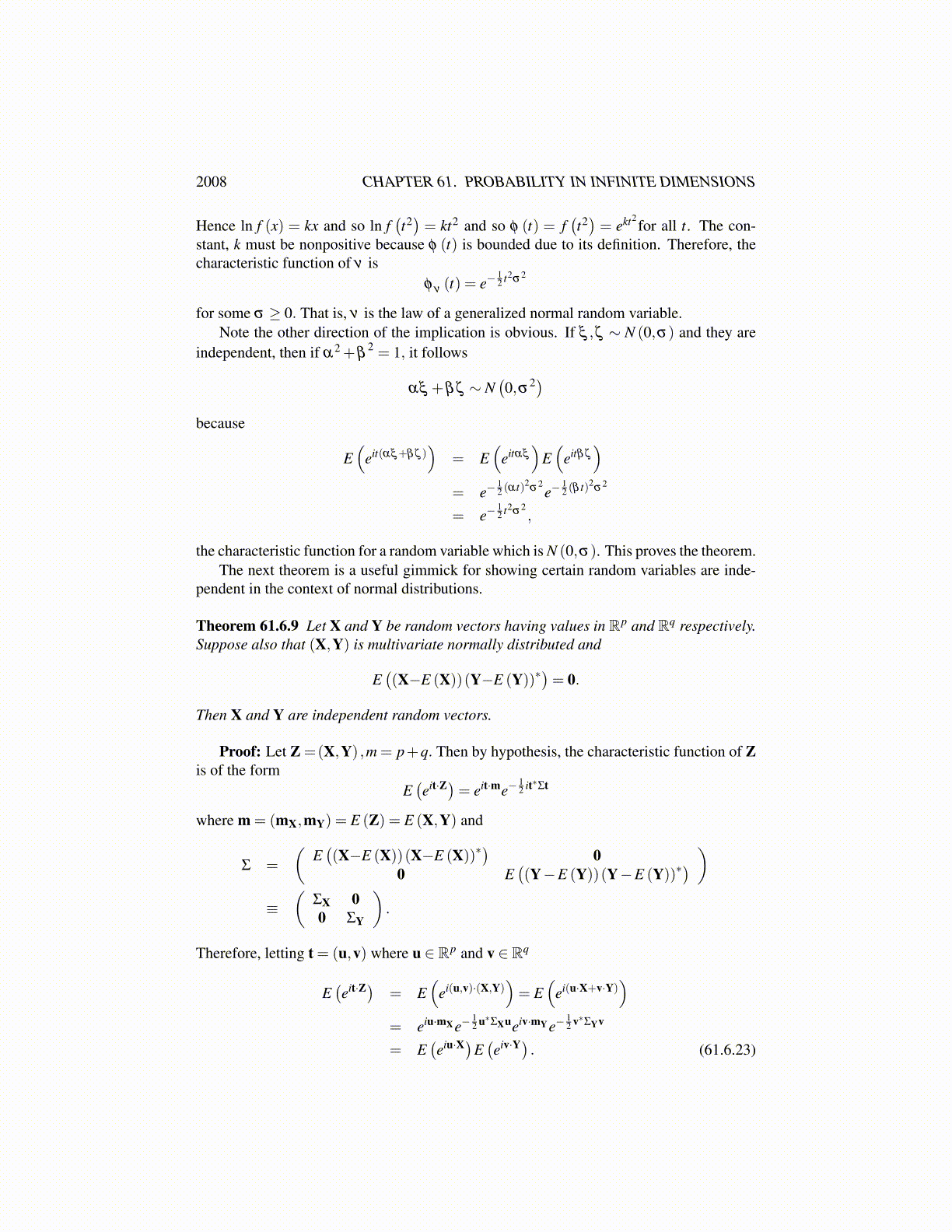
2008 CHAPTER 61. PROBABILITY IN INFINITE DIMENSIONS
Theorem 61.6.6 Suppose X = (X1, · · · ,Xp) is normally distributed with mean m and co-variance Σ. Then if X1 is uncorrelated with any of the Xi,
E ((X1−m1)(X j−m j)) = 0 for j > 1
then X1 and (X2, · · · ,Xp) are both normally distributed and the two random vectors areindependent. Here m j ≡ E (X j) .
Next I will consider the question of existence of independent random variables havinga given law.
Lemma 61.6.7 Let µ be a probability measure on B (E) , the Borel subsets of a separablereal Banach space. Then there exists a probability space (Ω,F ,P) and two independentrandom variables, X ,Y mapping Ω to E such that L (X) = L (Y ) = µ.
Proof: First note that if A,B are Borel sets of E then A×B is a Borel set in E×E wherethe norm on E×E is given by
||(x,y)|| ≡max(||x|| , ||y||) .
This can be proved by letting A be open and considering
G ≡ {B ∈B (E) : A×B ∈B (A×B)} .
Show G is a σ algebra and it contains the open sets. Therefore, this will show A×B is inB (A×B) whenever A is open and B is Borel. Next repeat a similar argument to show thatthis is true whenever either set is Borel. Since E is separable, it is completely separableand so is E×E. Thus every open set in E×E is the union of balls from a countable set.However, these balls are of the form B1×B2 where Bi is a ball in E. Now let
K ≡ {A×B : A,B are Borel}
Then K ⊆B (E×E) as was just shown and also every open set from E×E is in σ (K ).It follows σ (K ) equals the σ algebra of product measurable sets, B (E)×B (E) and youcan consider the product measure, µ×µ . By Skorokhod’s theorem, Theorem 61.4.3, thereexists (X ,Y ) a random variable with values in E ×E and a probability space, (Ω,F ,P)such that L ((X ,Y )) = µ×µ . Then for A,B Borel sets in E
P(X ∈ A,Y ∈ B) = (µ×µ)(A×B) = µ (A)µ (B) .
Also, P(X ∈ A) = P(X ∈ A,Y ∈ E) = µ (A) and similarly, P(Y ∈ B) = µ (B) showingL (X) = L (Y ) = µ and X ,Y are independent.
Now here is an interesting theorem in [36].
Theorem 61.6.8 Suppose ν is a probability measure on the Borel sets of R and supposethat ξ and ζ are independent random variables such that L (ξ ) = L (ζ ) = ν and when-ever α2 +β
2 = 1 it follows L (αξ +βζ ) = ν . Then
L (ξ ) = N(0,σ2)
for some σ ≥ 0. Also if L (ξ ) = L (ζ ) = N(0,σ2
)where ξ ,ζ are independent, then if
α2 +β2 = 1, it follows L (αξ +βζ ) = N
(0,σ2
).